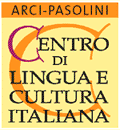 |
| Contact |
| Language Courses |
|
|
||||||||||||||||||||||||||||||
University Credits
|
||||||||||||||||||||||||||||||
Common European framework of reference for languages |
|
Beginner level |
Italian A1 |
Elementary level |
Italian A2 |
Lower intermediate level |
Italian B1 |
Upper intermediate level |
Italian B2 |
Lower advanced level |
Italian C1 |
Upper advanced level |
Italian C2 |
Click here for
European language levels - Self Assessment Grid
Our course levels refer to the official Common European Framework (CEF) for languages. These levels are commonly used throughout Europe and they match the levels of the Inter-Agency Language Roundtable and the American Council on the Teaching of Foreign Languages (ACTFL) approximately as shown in the table below:
Pier Paolo Pasolini Language Courses |
ACTFL |
| Italian - A1 | Novice high |
| Italian - A2 | Intermediate mid. |
| Italian - B1 | Intermediate high |
| Italian - B2 | Advanced mid. |
| Italian - C1 | Advanced high - Superior low |
| Italian - C2 | Superior - Distinguished |
These mappings are only an approximation, as there is no officially recognized mapping scheme at the moment. System, levels, syllabi and mappings used may therefore vary, depending on your university,
All standard Italian language courses at our language school take 22.5 hours (60 minutes each) weekly and a successful completion takes 1 or 2 weeks, depending on your progress and prior knowledge (B2, C1 and C2 may last longer). It is also possible to improve your progress by taking additional private lessons in the afternoon.
Our information office will be glad to send your language department or responsible professor the syllabus for your level.
At the end of the course, you will receive a certificate with your grade. The grade on your certificate is given on an A-F system where A is best and F is worst. Receiving a D generally means you successfully accomplished more than 50 percent, which means you passed, but this may vary depending on the requirements set by your university. The grades are based on attendance, participation, written assignments and, optionally, a final exam (depending on requirements).
 |
|
Authorized Exam Center |
| Arrivederci a |
| Castiglioncello ! |

